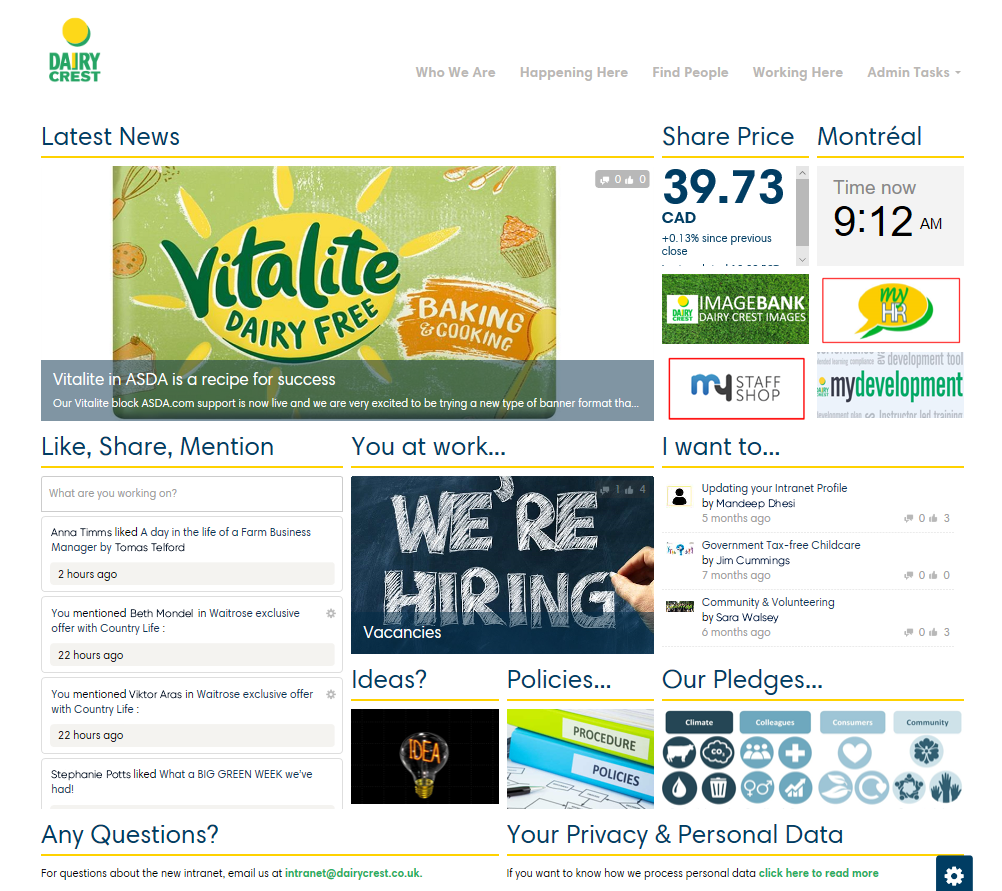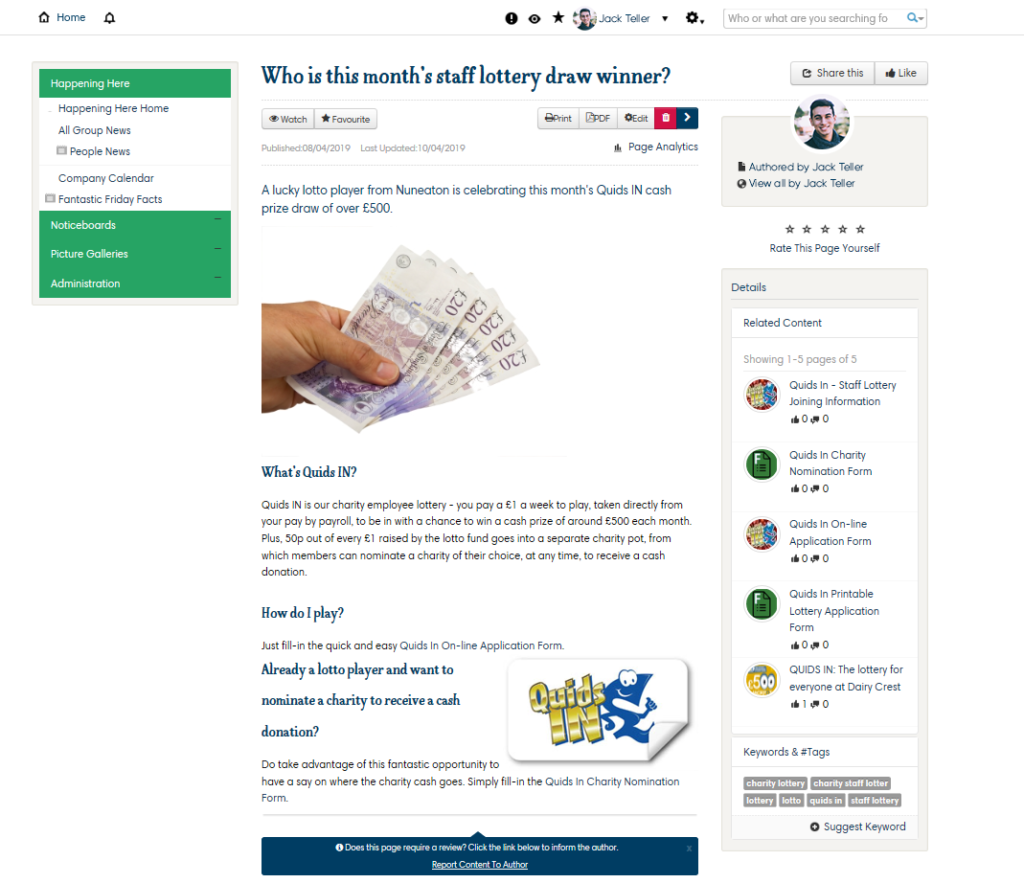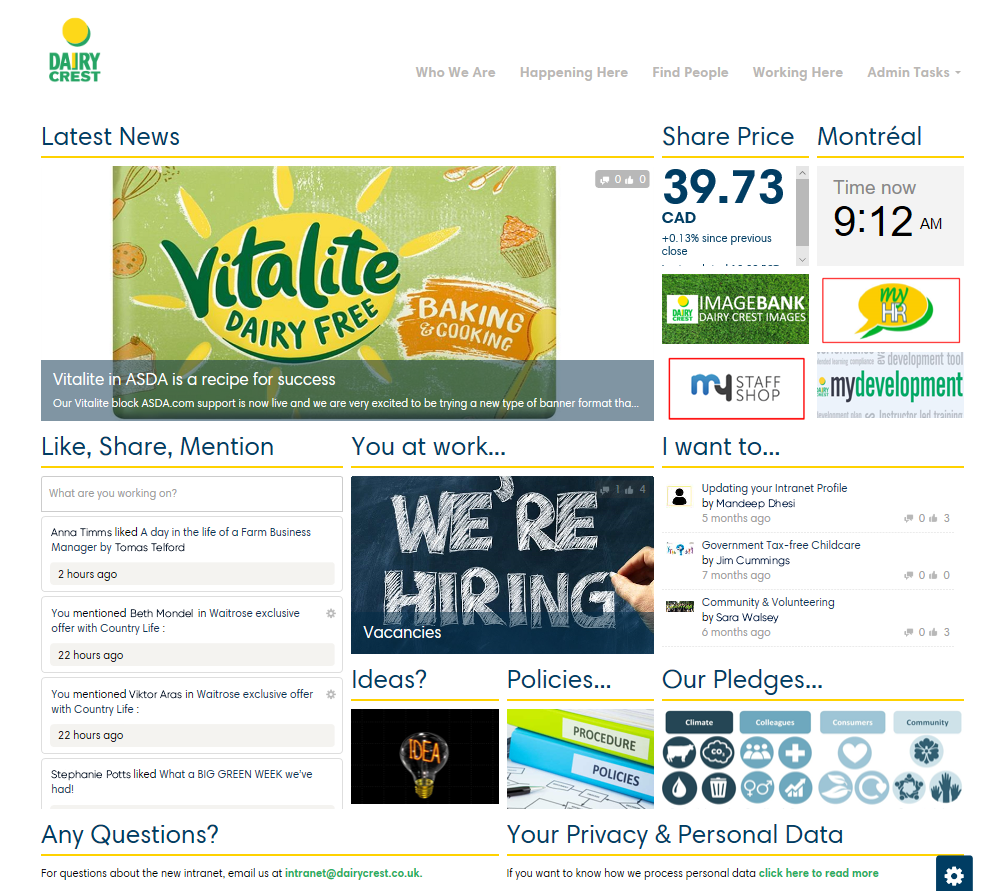From dumping ground to company cornerstone: the Dairy Crest intranet story

In an ideal world, overthrowing an ancient, obsolete system to replace it with a transformative, shiny, new intranet would be a task shared amongst a team of likeminded individuals.
Unfortunately, in the real world, time, money and resources often play against us. At least this was the case for Dairy Crest, a leading British dairy company. When the decision was made to partner with Interact to build a new intranet, a two-person team was all that was available to focus on the project: a tough, but not impossible, challenge.
The organization was at a point where an intranet was crucial to its day-to-day running. Having sold its dairy business and Frijj milkshake brand to Müller in 2015, Dairy Crest had been listed on the London Stock Exchange before being acquired by Saputo in April 2019. This period of great change required a system to unite all corners of the organization and raised a number of important intranet use cases.
Sam Coop, Communications Manager at Dairy Crest, together with her colleague Kevin Coyle, the Business Change Manager, were the sole members of the intranet build team. While they had their work cut out for them, their dynamic enabled a well-balanced build. Kevin not only had a project management and change management background, he was also in IT, so this lent a technical aspect to the build. Sam Coop, on the other hand, specializes in Communications so provided a more user-centric viewpoint. As Coop points out, “The collaboration between our two departments really hit the sweet spot.”
The problems of an outdated “intranet” system
The old system had a host of problems: a broken search function, a mass of outdated content and no way of carrying out version control. However, one of the biggest challenges the team faced was trying to change the mindset of Dairy Crest employees and convince them that a new intranet could be revolutionary for the business.
The term ‘intranet’ was a dirty word because the staff related it to a system that didn’t work.
Sam Coop
As Coop describes it, the old intranet was “a very out of date dumping ground for documents”. Despite this, it was surprisingly well used which proved that there was clearly a need for a closed network within the company. This helped bolster the decision to move away from the ADX file-sharing site and look for something more up-to-date.
Choosing the right intranet service provider
Dairy Crest was looking for an organization which specialized in intranets as their main business. More specifically, they were also looking for a company which had a clear understanding of the internal comms challenges of a business and could create a user-centric platform that helped with company-wide engagement. The team went to a number of workshops and eventually saw that there was a clear overall winner when it came to functionality, service, cost, and people.
Interact proved to be the best fit. “The workshops were well run, with really knowledgeable presenters, and we noticed that while these sessions were a good opportunity to sell the product, Interact actually came at it from a problem-solving angle.”
“We had certain criteria we needed to fulfill, and Interact could cover all of them.”
Sam Coop, Dairy Crest
The team knew that the service they would receive from Interact would put the user at the heart of everything.
Rebuilding from scratch
An old intranet can do a lot of damage to people’s opinions of what a system can do. According to Coop, even the term ‘intranet’ was a “dirty word because the staff related it to a system that didn’t work”. In order to rebuild trust, the small team paid attention to making sure content was recent and relevant.
There were several other goals that the team wanted the intranet to achieve. These included the ability to:
Self-serve: The self-serving aspect was a big priority, the team wanted to see a reduction in the number of questions and queries that HR and other overworked departments were dealing with day-to-day.
Search: Linking in with the self-serve function, the new intranet needed to allow people to find stuff quickly. Search is an underrated but hugely important function, and the team knew that if executed correctly, it would underpin employee engagement across the workforce.
Collaboration: Enabling people to work together was also a key area that needed improving. The intranet team wanted people to be able to see the intranet as a connecting tool – and something they could use to work with one another.
Social: Visibility of people was important to, so every profile has an image and a contact name and a way of getting in touch with one another. Posting a message on their page, or just simply putting a face to a name was transformative in a large organization that previously had no other way of identifying teams, departments, or senior-level management who worked across different locations.
With these four pillars, the team had a structure that aligned with the direction of the business, benefitted staff and enhanced the productivity and efficiency of the whole organization.

The launch
There was immense pressure on the small intranet team to deliver a site that was fully functional. Prior to the system’s launch, the team made the wise decision to forego the usual razzmatazz of an intranet launch day and focus on ensuring the site was user-ready. This removed the burden of a formal introduction and allowed the team to concentrate on making sure the general release went to plan.
“When we launched, we knew we’d be on to a win-win by just getting the search to work. But on the day, we received phenomenal feedback straightaway. People were commenting on how it looked and were amazed at how quickly they could find things they needed. We’ve definitely delivered, and I think we’ve also surpassed people’s expectations of what an intranet could be.”
Sam Coop
The positive feedback was a huge boost to Coop and Coyle who carried on making adjustments and improvements to the site after going live.
The difference between night and day
After the soft launch, it was now time to check in on the data to see how the system had bedded-in with the staff. The stats were hugely encouraging: with 86% of users accessing the site within the first six weeks of going live. This period saw an uplift in the pages of content published on the site, and this has grown as more people are trained to add their blogs, posts, and messages.
As of today, their active users stand at 95%, the self-service box has been ticked, and more and more authors are coming on board. In terms of what the new intranet has offered to the organization, “It’s the difference between night and day. The new system has been like taking a stone out of your shoe,” according to Coop.

Most popular parts of the intranet
Analyzing the stats of intranet usage across the organization is an important part of site management. In order to learn and make improvements, Dairy Crest needs to see changes in behavior, trends and any developments. The most visited pages tend to be HR-related, like booking annual leave or claiming expenses. There is also a lot of traffic going to the job vacancy page and the discount offers page.
“It’s really important to us that we keep an eye on habits and interests. If you tap into that, you can tailor your content to be more user-centric.”
Sam Coop
Dairy Crest is keen to use the intranet to push civic engagement, particularly in the community and volunteering side of things. The Employee Lottery is very popular across the whole organization. People can sign up to pay a small amount out of the salary per week where 50% goes into a charity fund, and the other 50% goes into the cash-draw. Sam Coop explains, “People can nominate charities to receive donations and because we’ve been able to build a form online, where before they would have had to get something printed off and fill it in, now they can just literally punch in their name. The cash goes into a pot to win and then the other half sits there waiting to be donated to charities of our workforce’s choosing.”
Moving forwards
The success of the system is down to the well-thought-out strategy carried out by the team’s pre-build as well as having the combination of IT and comms from the very beginning. While the technical side was taken care of, the team was able to concentrate on the user’s experience, making sure the needs and behaviors of the employees were taken into consideration.

The intranet has been a triumph within the organization. But while the team has celebrated the build and launch of the system – both major milestones – they are aware that they are still only at the beginning of their intranet journey and are now focusing on continuous improvement.
“It’s the difference between night and day. The new system has been like taking a stone out of your shoe.”
Sam Coop
